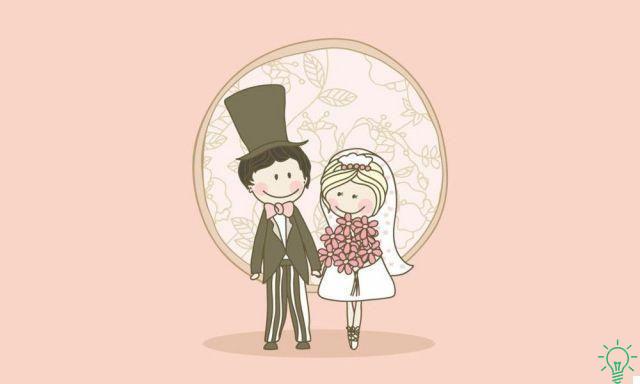The couple or two-person test is an interesting projective tool that can give us various information. The most important is the type of bond that these two figures have between them and the quality of the same.

Written and verified by the psychologist GetPersonalGrowth.
Last update: 15 November 2022
The psychological test for couples (or for two people) is a projective examination. Its purpose is to identify the identity and the type of bond established between two people. Furthermore, through this test, it is often possible to glimpse factors, such as anxiety, hidden desires, fantasies and even possible conflicts, latent in a relationship, regardless of whether it is a couple, a family, a friendship, etc.
It is one of the most interesting projective tools, but also one of the most complex when it comes to evaluating. We are not faced with the classic test that involves a design such as the tree test or the family test. In this case, we are talking about an exercise in which the subject under examination has to perform two different tasks. On the one hand, a drawing; on the other hand, to create a story.
The data that can be obtained from this tool can be particularly relevant, as long as the subject cooperates. Sometimes, the patient's age or even the presence of a mental disorder can make it difficult to perform this test.
Its application, however, is generally limited to cases relating to couple relationships; for this reason, the information obtained is often interesting. Let's see it in more detail.
Psychological test for couples (or for two people): purpose, execution and interpretation
The psychological test for couples (or for two people) was devised by Douglas Bernstein in 1964. To elaborate it, he relied on the Manchover human figure test. The latter tool was intended to evaluate concepts such as self-esteem, self-perception, personality traits, fears, desires, traumas, etc.
Now, if Bernstein published his couple or two-person test, there is a specific reason: he wanted to have a projective tool with which to evaluate the relational factor. In this way he could have assessed how an individual perceives and lives his connection with the people who are important to him.
Conscious and unconscious aspects are therefore evaluated, because in addition to drawing, this test requires you to develop a story about the two figures you mold on the sheet. We will therefore trace something that characterizes, in part, our lives: stories. Each person creates their own reality on the basis of a story to which each one gives a sense, positive or negative. Sometimes it can be real, others it can stand on distorted, false or even invented ideas by virtue of a defense mechanism.
What does the couple psychological test evaluate?
This test evaluates everyday relationships. The subject is asked to represent himself and his relationship with a person dear to him (or her). We investigate to know aspects of the personality and, in particular, the quality of this relationship.
As we said, aspects of which we are conscious and others unconscious may emerge. Real facts may emerge (such as communication problems, lack of affection, etc.), but also hidden desires (need for recognition, lack of attention ...).
It can be performed on children aged 7 and over. However, its application usually serves to know the quality of the relationship between the members of a couple.
How is it done?
We explain it step by step:
- A sheet and a pencil are delivered.
- You ask to draw two people (without specifying who it should be).
- Once the drawing is finished, the patient is asked to give a name and an age to the figures.
- Then you have to ask to write a short story about these two people, followed by a description of their thoughts and emotions.
- Finally, we need to give the story a title.
Interpretation of the psychological couple test
The interpretation of this projective test is based on three aspects:
Technical Information
- Gender, age and relationship with the person being assessed.
- Realistic image or one impregnated with a certain talent of fantasy.
- What does the couple do? Speak, walk hand in hand, is there distance between the figures?
Latent aspects
- Which figure does the person assessed represent? Does it play a particular role (passive, paternal, maternal, subordinate, elusive figure…)?
- What does it project onto the other person? Does he need affection, fear, distance, desire?
- Is there rejection between the two figures? Is there some kind of contact or form of communication?
Graphic aspects
- We will evaluate the size and placement of the figures and the characteristics of the stroke (it is nervous, it was created with calmness and attention ...).
- Are they human-looking figures or are they caricatures? Is there a symbolic or attractive aspect (misshapen figures, evil aspect, etc.)?
Verbal aspects
- The type of story processed will be evaluated. What can we deduce from it? Are we facing a happy person, who has emotional deficiencies, needs, fear, etc.?
- Distinguish between aspects that refer to real facts from those that symbolize desires or aspirations.
- Consistency in history.
- Context in which the story is placed.
- Evaluation of the chosen title (does it represent the story? What kind of message does it convey? Why was this particular title chosen?).
Finally, if you are wondering how reliable this test is, it must be said that it is a projective test. In other words, an assistive instrument, which in itself does not allow to formulate a diagnosis. It is used as supplementary material for other tests and interviews through which to try to obtain as much information as possible. However, this does not make it a less interesting test from which a specialist cannot take advantage.


























